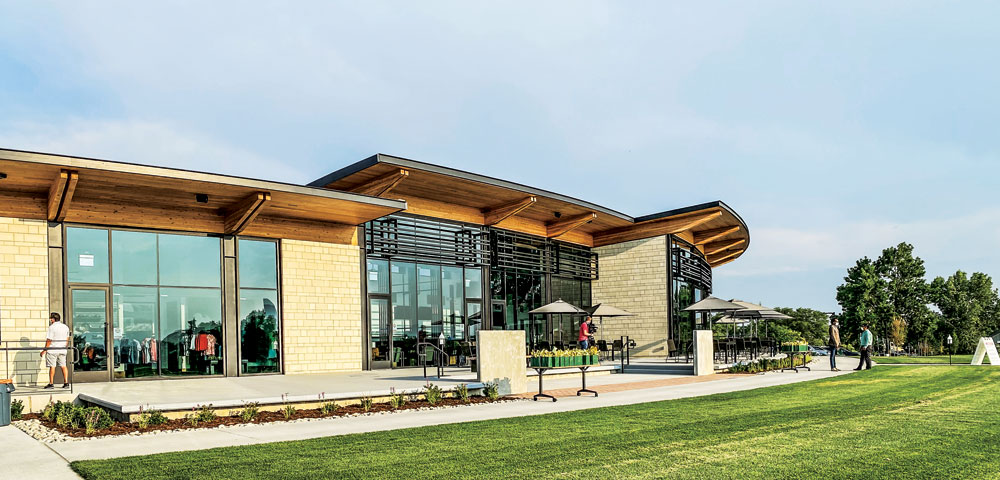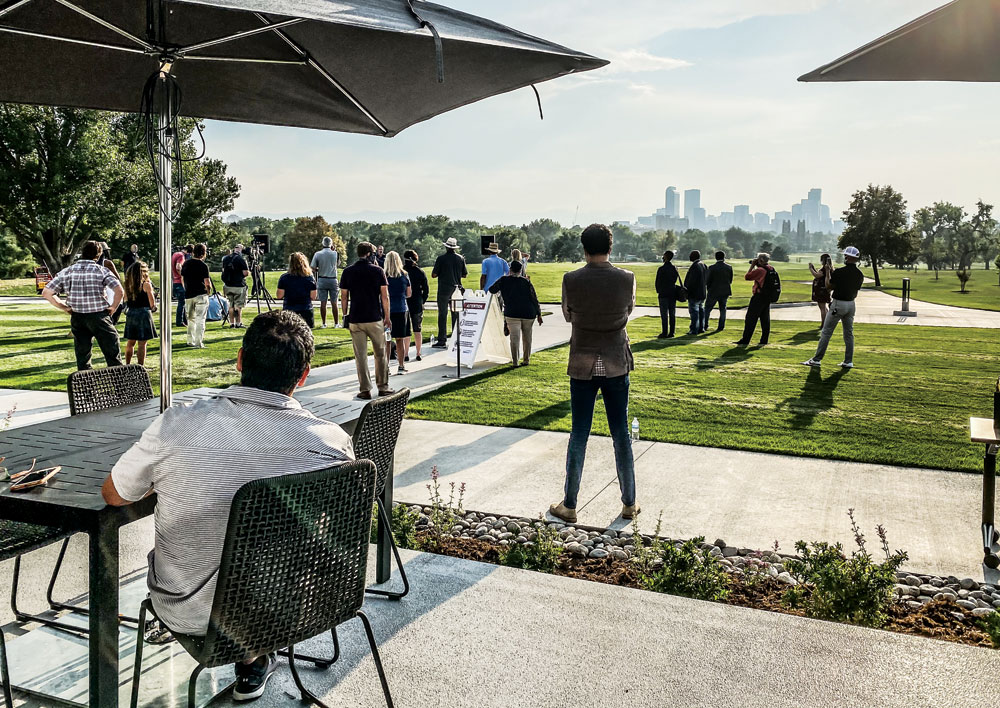
City Park Golf Course, with its stunning views of the downtown skyline and mountains, reopened Sept. 1 after a major redesign of the course, construction of a new clubhouse, and engineering improvements that reduce the potential for flooding in neighborhoods to the north.
Denver’s historic City Park Golf Course reopened September 1 after years of major work and considerable controversy that spanned petitions, protests and even a lawsuit over the now-completed changes. The new course includes both an 18-hole course and a full-size driving range, along with a new clubhouse and deck, and a dedicated four-hole course for the popular youth program, The First Tee of Denver.
• VIDEO FROM THE SNEAK PEAK EVENT AT CITY PARK GOLF COURSE •

The expansive windows of the 11,315 sq. ft. clubhouse offer panoramic westerly views of downtown Denver and the mountains. Within the clubhouse are a host of services, including a restaurant and bar, a full catering kitchen, a pro shop, offices, conference rooms, and programming spaces available for community events and private parties up to 200 people. The 10,840 square foot basement stores 80 golf carts and electrical chargers, wash stations and maintenance services.
Media accounts and public documents suggest that when the project began in 2016, no one seemed to argue with the proposal to update the course and add modern facilities. The proposed stormwater detention pond, however, raised concerns from many entities. City Park Friends and Neighbors (CPFAN) and Historic Denver are among the groups that voiced their opposition in letters, op-eds, community meetings, and even a lawsuit.

The dining room area, which can seat up to 144 people, features floor-to-ceiling windows overlooking a patio that can accommodate 50. Sustainability elements of the clubhouse include use of solar energy and locally sourced materials.
Current CPFAN president Georgia Garnsey says she is happy to see the project’s completion, but still feels the City was disingenuous in their reasons for its undertaking. “We understood from City documents that they initiated the stormwater detention project primarily to satisfy federal requirements of the I-70 expansion and to provide stormwater flooding protection for the Western Stock Show and the Corridor of Opportunity real estate developments. Protecting the neighborhoods surrounding the course from flooding was secondary, with minimal benefits.”

Denver Mayor Michael B. Hancock and other city officials celebrated the completion of the new City Park Golf Course at a Sneak Peak event on Aug. 20. The view from the clubhouse patio looks out on the 135-acre golf course and a spectacular view of the Denver skyline.
Nancy Kuhn, Director of Public Information for Denver’s Department of Transportation and Infrastructure (DOTI) refutes this idea, as does Sam Stevens, an engineer with DOTI’s Infrastructure Project Management. “The Montclair Basin is really the largest drainage basin within the city of Denver without a big drainage channel. The majority of our pipes were built over a hundred years ago, so we don’t have really any way to move flood waters from this basin into the South Platte River where they belong. As the community built up, they forgot about the natural channels that were in this basin and just developed on top of them, so we do have significant flooding in the space and historically the streets flood, and the pipes only have capacity for a five-year flood,” Stevens says.

Happy Haynes, Executive Director of Denver Parks & Rec, hits some balls on the new and much larger practice green.
“First and foremost, this was a stormwater management project. By using this golf course where the water was already naturally collecting we were able to avoid having to try to solve this problem by trying to obtain private property,” says Kuhn. Regrading the golf course, she says, allows it to capture more water and manage the flow.

The beauty of the new golf course overlooking the city skyline is captured in this sunset photo. In addition to a better and more attractive course, the redesign also created a stormwater detention area that can hold 68 million gallons of water in a 100-year storm event, reducing flood risks to the north. (The pond shown here is not part of the stormwater detention area.)
Though Garnsey appreciates that the golf course looks more interesting now, she worries about the environmental impact of removing mature trees in a City that’s short of green spaces and canopy. “I feel sorrow when I go by,” she says, “a soft sorrow for the fact that I believe it wasn’t done for the right reasons.”
City Golf Director Scott Rethlake says the 256 trees removed for this project dated to the 1960s. “We take about 25-40 trees each year due to their age, or health and safety concerns. This project actually gave us a really good opportunity to do succession planning with the trees.” The City planted about 760 saplings, ensuring that as older trees age out, these saplings will be mature, healthy trees forming an even larger canopy than before. Rethlake says the City will again apply for the golf course’s certification as an Audubon International (AI) sanctuary (the status is not based on birds, as the Audubon name implies, but on environmental planning, chemical use reduction and other components). He expects AI will renew in 2021.
Scottish immigrant Thomas Bendelow designed the original course, which dated to 1913. Bendelow, “The Johnny Appleseed of American golf,” designed over 600 courses nationwide, and the Denver course is one of only two on the National Register of Historic Places according to The Cultural Landscape Foundation.
Rethlake admits “it is not a Tom Bendelow design anymore,” but says “what was in the historic registry were its park-like feel and the viewsheds, a grove of trees, and things like that. We did protect those things that were in the historic registry.” National and State Register Historian Jason O’Brien with History Colorado affirms this; the Bendelow design was not germane to the golf course’s inclusion on the historic registry, and the course remains part of the Denver Park and Parkway System’s historic designation.
Though open to the public, social distancing and new grass mean limited rounds for now. Once the grass is well-established, the City will remove the perimeter fencing, offer expanded play, and permit golf carts.
Front Porch photos by Christie Gosch



Why would you not mention the golf course architect?
Great question! This was a story with a lot of different ideas and voices, and given our space limitations we just couldn’t include it all. The extensive NE Denver neighborhood conflict over the project moved us to prioritize those elements (the flood control aspects and the question of historic status). Those subjects, it seemed to us, were of broad public interest whereas the golf course architect and the clubhouse architect would be more specifically of interest to the subgroup of readers who are golfers. Thank you for your comment!